Plug-in hybrids are the perfect solution for drivers that want to try an electric vehicle but aren’t quite ready to go all in on an EV. True to form, the redesigned 2023 Mitsubishi Outlander PHEV delivers the smooth, silent, efficient operation of an electric with the long range and quick refueling of internal combustion. The vehicle isn’t necessarily more than the sum of its parts, though it still delivers the best of both worlds.
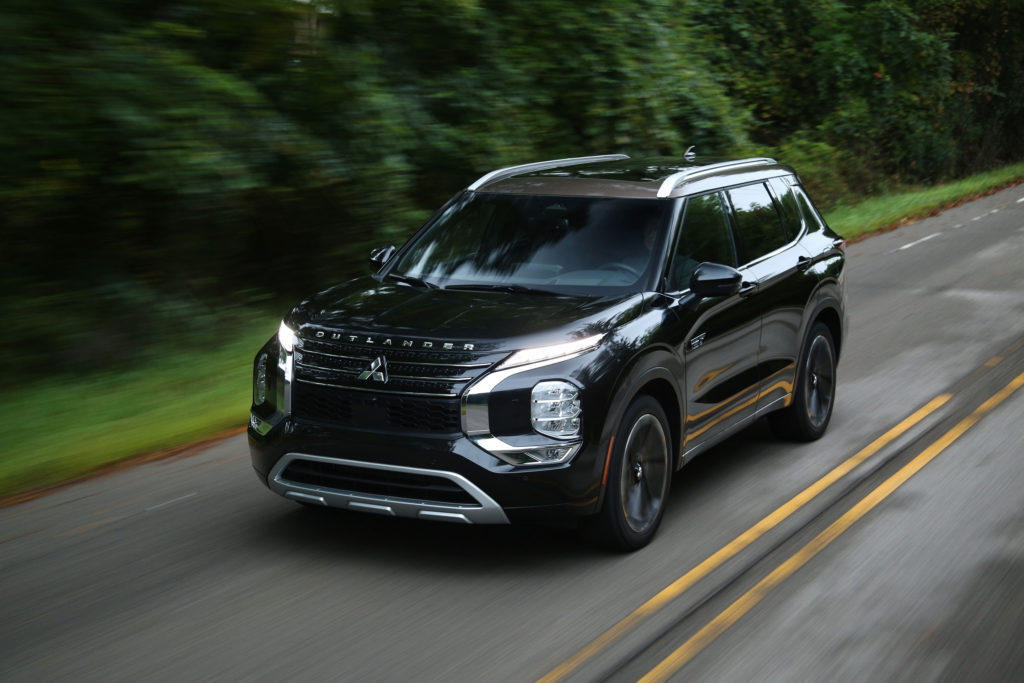
Now in its second generation, this pioneering plug-in hybrid SUV is the de facto flagship vehicle for Mitsubishi, an automotive brand that hasn’t been top of mind for quite some time, though the Outlander PHEV is a more-than-worthy small utility vehicle. The latest generation of the conventional Outlander went on sale about a year and a half ago and its introduction proved to be an inflection point for Mitsubishi. This SUV rejuvenated the automaker’s tarnished image and dramatically improved sales.
Even though it has a unique powertrain, the Outlander PHEV is still ultimately a reskinned version of the Nissan Rogue. The structure, interior controls, infotainment system, shifter and countless other components are all borrowed from Nissan, which is not necessarily a bad thing. If you look carefully, it’s easy to spot this Mitsubishi’s Rogue roots, but aside from the electrified drivetrain, exterior and interior design is what sets this Mitsubishi apart.
The front end is aggressive and distinctive, a version of the automaker’s so-called “Dynamic Shield” design theme. In photos and videos this SUV looks a bit odd, perhaps too angular, but in person the vehicle is much more attractive, so don’t judge the Outlander until you see one up close.
Lighting the way, LED headlamps are standard equipment, fitted in large assemblies mounted above the fog lights but below the leering daytime running light/turn signal housings. Prominent badges adorn the vehicle’s front doors, letting other drivers know the Outlander PHEV features an electrified powertrain. When it comes to wheels, the base model rolls on 18-inchers but larger 20s are also offered. This Mitsubishi’s rear end is uncluttered and attractive, much simpler and less aggressive than its prow.
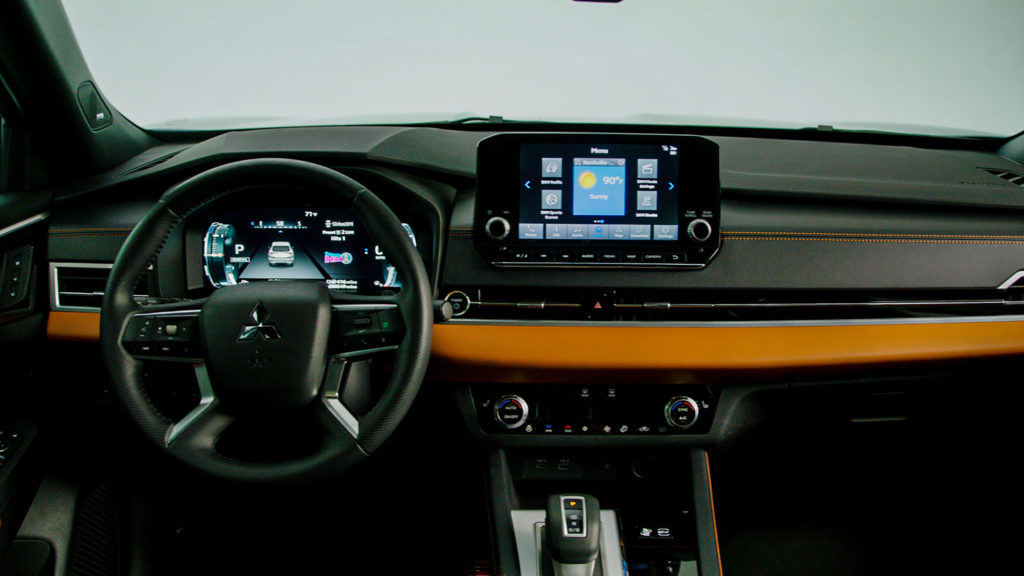
Where the Outlander really shines, however, is inside. This SUV’s cabin is beautifully designed and solidly constructed. The dashboard is clean and elegant plus the materials used are excellent for this class of vehicle. I particularly like the available black-and-tan color scheme as well as the quilted stitching on the seats and door panels. Overall, this interior is noticeably nicer than what you get in the Ford Escape PHEV and Toyota RAV4 Prime, this Mitsubishi’s core plug-in rivals.
The Outlander’s front bucket chairs are plenty comfortable and even offer massage functionality, something that helps keep fatigue at bay on long trips. Unlike other small SUVs, this one also comes with a standard third-row seat. Now don’t get too excited, this rearmost bench will realistically only accommodate children — and small ones at that — but it’s still nice to have in an emergency.
Two displays are found on the dashboard, a standard 12.3-inch digital instrument cluster and a 9-inch center touch screen. Keeping pace with rival vehicles, the Outlander’s infotainment system supports smartphone mirroring through Android Auto and Apple CarPlay, the latter of which can connect wirelessly.
Increasing this SUV’s versatility, the Outlander PHEV also features a 1,500-Watt power outlet in the cargo area, something that’s always nice to have, especially when camping or tailgating. That socket is potent enough to run a vacuum cleaner, hair dryer or even a coffee maker, appliances that can draw a lot of juice.
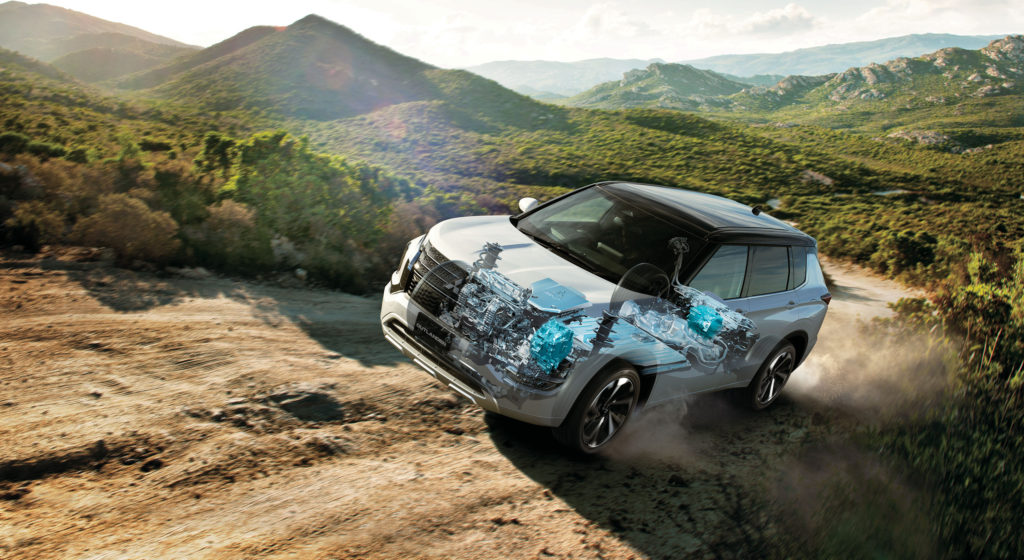
Conventional Outlanders are motivated by a 2.5-liter gasoline power plant sourced from Nissan, but the Outlander PHEV’s powertrain is built around a Mitsubishi-designed 2.4-liter MIVEC four-cylinder engine. An 85-kilowatt electric motor helps out up front, while a 100-kW dynamo powers the rear wheels and provides standard all-wheel drive, something that’s also included at no extra charge on the RAV4 Prime; the Escape PHEV, however, is not available with all-wheel drive. Working together, the engine and electric motors provide 248 system horsepower and 332 pound-feet of torque, giving this plug-in SUV a significant performance advantage over the conventionally powered Outlander.
Mitsubishi’s electrified powertrain can operate as either a series or parallel hybrid depending on conditions. The engine can spin the generator that feeds power into the battery for running the electric motors, or, at speeds north of about 70 km/h (44 mph) the engine can directly drive the front wheels through a special clutch. Similar to Honda’s two-motor hybrid system, this design is lighter and less expensive than systems that use electronically controlled continuously variable transmissions.
There’s a lot going on under the hood, but this system is remarkably smooth. Stop-start events for the gasoline engine are imperceptible — oftentimes you have no idea the thing is even running. Of course, in certain situations the engine’s voice can be heard, though it’s generally not intrusive.
The Outlander PHEV’s 20-kilowatt-hour lithium-ion battery is supplied by AESC and provides an estimated 38 miles of electric-only range, plenty for many drivers’ commutes and right in line with the Escape PHEV (37 miles) and the RAV4 Prime (42 miles). With the gas tank factored in, this SUV offers a theoretical maximum range of 420 miles. Thanks to the additional hardware needed by the hybrid system, plug-in Outlanders are about 440 pounds heavier than combustion-powered models.
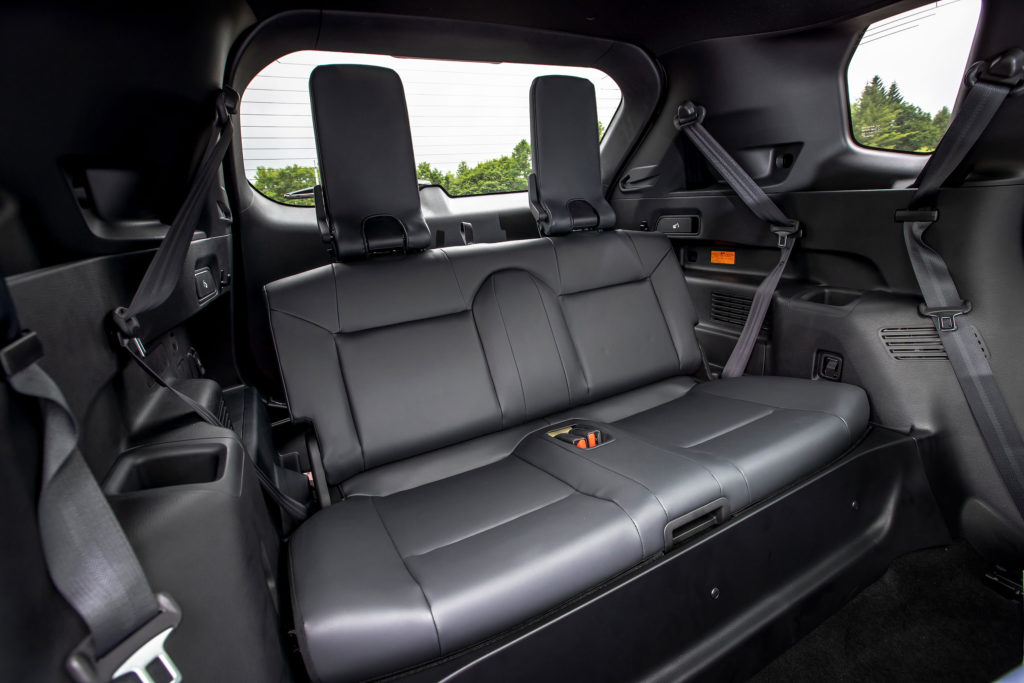
The Outlander PHEV’s battery pack can Level 2 charge from a 240-volt AC power source in about 6.5 hours. DC fast charging through the CHAdeMO port — an exceedingly strange choice for a vehicle in 2023 because the Nissan Leaf is about the only other vehicle sold in the U.S. that has one — can get you to 80% in about 38 minutes. Finally, while driving or stationary you can use the internal-combustion engine to replenish the battery. Depending on conditions, doing so can get you to 80% in as little as 30 minutes.
This Mitsubishi SUV offers four separate powertrain modes: There’s Normal, which balances performance and efficiency; EV runs the Outlander solely on the battery up to 83 mph unless you floor the accelerator, at which point the engine will engage to provide more oomph; Charge allows you to replenish the battery with the engine while driving or stationary; and Save preserves electric range so it can be used later, ideally when it’s most efficient to do so, such as when driving in an urban area.
Beyond all that, there are seven different drive modes, selectable via a dial on the center console. There’s Normal, Tarmac, Gravel, Snow, Mud, Eco and Power. Each one adjusts the vehicle’s performance and handing for varying conditions, though I’m not sure how many drivers will actually use this feature.
Running on internal combustion, expect 25 miles per gallon in city driving, 27 on the highway and 26 MPG in mixed use. When the engine and electric motors are working together, the Outlander should return up to 64 MPGe combined, that’s miles per gallon equivalent. In mixed driving on back country roads and interstate highways using the battery’s full capacity we got an estimated 50 mpg from the vehicle.
This Mitsubishi certainly is efficient, but the Escape plug-in and RAV4 Prime are both significantly more economical. The front-drive-only Ford is rated at 105 MPGe and 40 miles per gallon combined, while the Toyota returns 94 and 38, respectively.
The Outlander plug-in is pleasant enough to drive, with plenty of torque for quick getaways. Mitsubishi has not published an official 0-to-60-mph time, but some publications have clocked this vehicle 6.5 seconds, which is legitimately quick. Despite its straight-line vigor, this SUV is not particularly sporty or involving. The steering is vague and the vehicle wanders. Also, the brake pedal is mushy and imprecise, yet somehow still grabby. A little more tuning work here would be appreciated.
Even though a true one-pedal driving mode is not offered, regenerative braking is included, so you can recuperate energy that would normally be wasted. Paddles on the steering wheel allow you to adjust how aggressive this is, from almost nothing to a noticeable amount. Maximum regenerative braking is achieved using a feature Mitsubishi calls Innovative Pedal. Accessible via a button on the center console, this blends regenerative and friction braking to approximate a one-pedal mode.
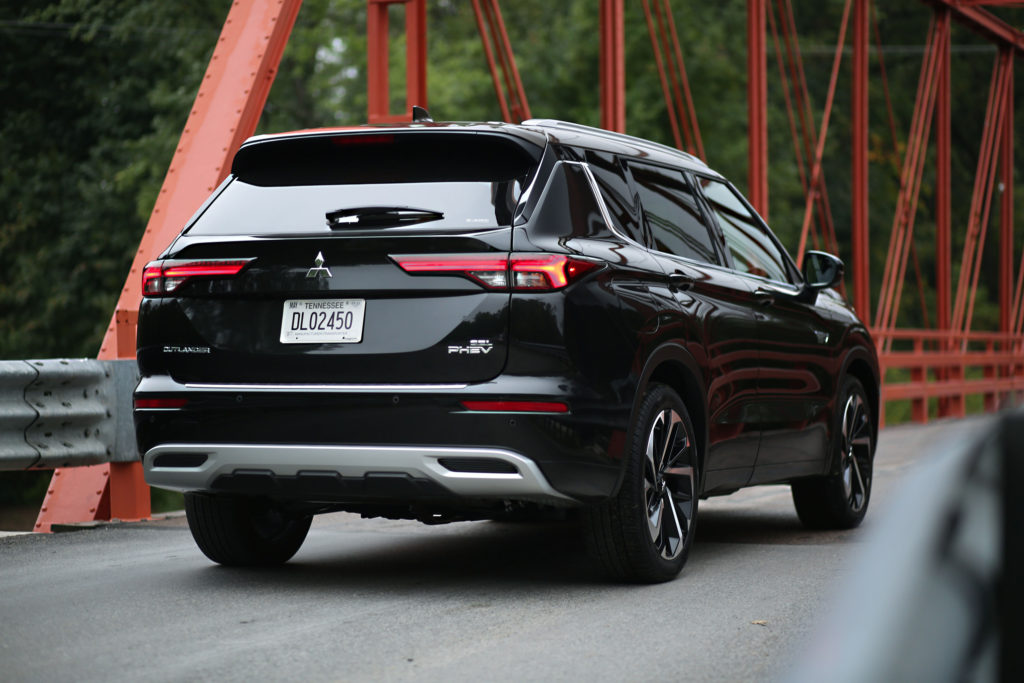
So, what does all this triple-diamond goodness cost? Well, the base ES model starts at about $41,000 including $1,345 in destination fees — if you live in Alaska or Hawaii, you’ll be paying $1,470 for delivery. This makes the Outlander PHEV a little cheaper than the Toyota RAV4 Prime, though the Escape PHEV undercuts this Mitsu slightly. Of course, a fully loaded model is going to cost more, around $51,000, though that is still a great value. The 2023 Outlander PHEV is available at Mitsubishi dealerships as you read this review.
With an excellent interior, a nice blend of performance and efficiency, distinctive styling and a standard third-row seat, this SUV is a solid choice that you should test drive if you’re looking for an economical and affordable small utility vehicle. In a lot of ways, Mitsubishi has built a better Nissan Rogue. Of course, some drivers might be concerned about buying a triple-diamond vehicle, though really, they shouldn’t be, because the 2023 Outlander PHEV comes with a stellar 5-year/60,000-mile basic warranty and 10-year/100,000-mile powertrain coverage, so it’s almost impossible to go wrong.
